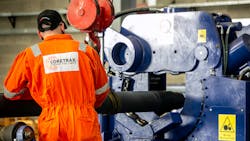Combined technologies deliver efficiencies for North Sea P&A campaign
By Mark Temple, Coretrax; and Ian McHattie, Lee Energy Systems Inc.
Plugging and Abandonment (P&A) is a necessary but costly stage of any well lifecycle. It is estimated that between 2021 and 2023 more than 1,700 wells will be decommissioned in the UK alone, with the highest number in the North Sea.
The UK Continental Shelf is home to some of the most mature fields in the world and with aging reserves, many operators must begin the complex task of decommissioning infrastructure, including wells.
As the industry continues to support net zero goals, decommissioning planning is more important than ever to ensure this activity is carried out as efficiently as possible. Technology is playing a key role in meeting these objectives, particularly during abandonment operations where it is critical to ensure flow is limited between the reservoir and the formation.
During a recent P&A project in the North Sea, Coretrax and Lee Energy Systems (LES), both experts in wellbore integrity and production, joined forces to deliver a one-trip solution utilizing Coretrax’s CX-2 bridge plug and CX-RTP (retrievable test packer) in conjunction with LES' GATOR Hydromechanical Perforator to garner greater efficiencies.Effective environmental barriers
Within just a few weeks, the two companies executed a detailed planning assessment to gain a full understanding of the current casing specifications and mobilized to the offshore asset. The CX-2 bridge plug was first deployed on a 5.5 inch pipe into the 9 5/8-inch 53.5# casing to provide a solid cement plug. The tool features a release system which, unlike other mechanical barriers, provides a slick stinger with a through-bore, eliminating the requirement for a dedicated cementing trip.
Designed to set with a combination of hydraulic pressure and mechanical pull, the system has a built-in setting mechanism, delivering improved efficiency through time savings. It is constructed with fully drillable materials and its slick outer diameter (OD) and large inner diameter (ID) minimizes cement disturbance when pulling out of hole.
Once at setting depth within the casing, it was successfully set, released and pressure tested. The GATOR was subsequently deployed and functioned to hydromechanically perforate, allowing for circulation between two sets of GATOR perforations, delivering successful remediation and cementing. The BHA was then retrieved to surface. The tool is an alternative to traditional perforating guns and requires no explosives, delivering a much safer solution. With four large total flow area slots in the casing creating unlimited perforations per run, the system delivers a 360-degree circulation flow path to the formation or annulus. This allowed an average cleanup rate of 20 bbl per minute at 500 psi.
The CX-RTP was then set, and following confirmed circulation, a drop ball circulation sub was opened to isolate the GATOR device below. Cement was subsequently pumped and squeezed into the perforated outer annulus before the CX-RTP was retrieved. In the final stage of the operation, cement left on top of the CX-2 was successfully tagged and pressure tested to ensure full integrity.
As the operator was keen to consolidate trips to further save rig time, engineering modifications were implemented to the Gator and CX-2 to ensure the technologies were compatible for use in this single trip application.
Technology-driven efficiencies
Across the eight wells, setting depths ranged from 850 ft to 4,000 ft. With an array of casing sizes also needed, all tools were successfully supplied and refurbished onshore between deployments. During the project, the average time to effectively P&A each well was 15.5 days, compared to the North Sea Transition Authority’s benchmark of 23 days, highlighting a 33% improvement on the industry standard.
At a time when cost and time efficiencies are vital, the collaboration clearly demonstrates the results that can be garnered through effective partnerships and innovative technology.





